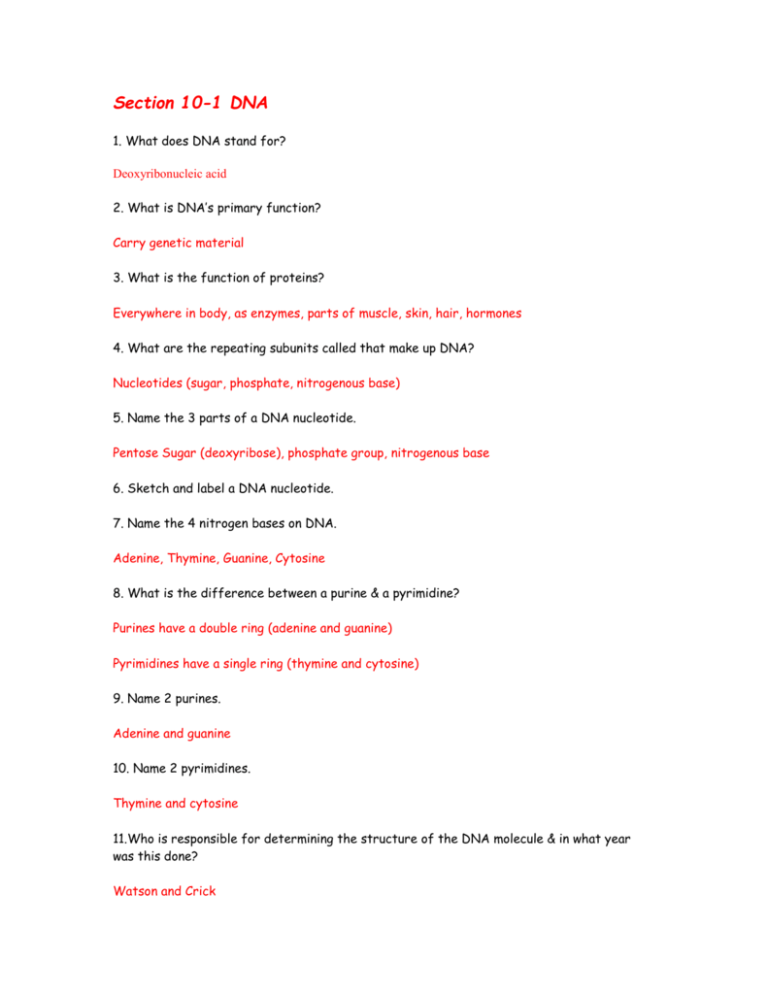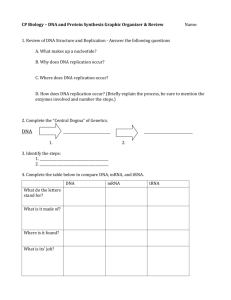protein synthesis answer key
advertisement

Section 10-1 DNA 1. What does DNA stand for? Deoxyribonucleic acid 2. What is DNA’s primary function? Carry genetic material 3. What is the function of proteins? Everywhere in body, as enzymes, parts of muscle, skin, hair, hormones 4. What are the repeating subunits called that make up DNA? Nucleotides (sugar, phosphate, nitrogenous base) 5. Name the 3 parts of a DNA nucleotide. Pentose Sugar (deoxyribose), phosphate group, nitrogenous base 6. Sketch and label a DNA nucleotide. 7. Name the 4 nitrogen bases on DNA. Adenine, Thymine, Guanine, Cytosine 8. What is the difference between a purine & a pyrimidine? Purines have a double ring (adenine and guanine) Pyrimidines have a single ring (thymine and cytosine) 9. Name 2 purines. Adenine and guanine 10. Name 2 pyrimidines. Thymine and cytosine 11.Who is responsible for determining the structure of the DNA molecule & in what year was this done? Watson and Crick 12. The model of DNA is known as a ______double helix______________________ because it is composed of two ___________________ chains wrapped around each other. 13. What makes up the sides of a DNA molecule? Sugar and phosphate 14. What makes up the "steps" of a DNA molecule? Nitrogenous bases 15. How did Rosalind Franklin contribute to determining the structure of DNA? x-ray crystallography 16. What type of bonds holds the DNA bases together? Are they strong or weak bonds? Hydrogen bonds, weak bonds 17. What makes up the "backbone" of the DNA molecule? Sugar phosphate backbone 18. On DNA, a _______pyrimidine_____________ base will always pair with a ____purine______________ base. 19. What is the most common form of DNA found in organisms? Nuclear DNA 20. How many base pairs are in a full turn or twist of a DNA molecule? 10 21. Name the complementary base pairs on DNA. A-T. C-G 22. How many hydrogen bonds link cytosine & guanine? adenine & thymine? Adenine and Thymine = 2 , cytosine and guanine = 3 23. How does the nucleotide sequence in one chain of DNA compare with the other chain of DNA? The same, but complimentary 24. Why must DNA be able to make copies of itself? For growth, repair, cell division 25. Define DNA replication. When the DNA is copied 26. What is the first step that must occur in DNA replication? Strands unwind and split up 27. What acts as the template in DNA replication? Original/Parent strand 28. What is a replication fork? Where replication begins 29. What enzymes help separate the 2 strands of nucleotides on DNA? What bonds do they break? Helicase and hydrogen bonds 30. What is the function of DNA polymerases? Match the complimentary base pairs to the template strand 31. _________nucleotides___________ are joined to replicating strands of DNA by ________covalent________ bonds. 32. If the sequence of nucleotides on the original DNA strand was A – G – G – C – T – A, what would be the nucleotide sequence on the complementary strand of DNA? T-C-C-G-A-T 33. Does replication of DNA begin at one end and proceed to the other? Explain. - no it begins in many places and goes in 2 directions 34. Why does DNA replication take place at many places on the molecule simultaneously? - there is so much DNA to replicate 35. When replication is complete, how do the 2 new DNA molecules compare to each other & the original DNA molecule? identical 36. Is DNA replicated (copied) before or after cell division? Before cell division 37. Sketch & label DNA replication. (Figure 10-5, page 188) 38. What is the error rate in DNA replication? What helps lower this error rate to 1 in 1 billion nucleotides? 39. What is a mutation? A change in DNA 40. Name several things that can cause DNA mutations. Chemicals, radiation, sun exposure Section 10-2 RNA 41. What sugar is found on DNA? deoxyribose 42. What base is missing on RNA, & what other base replaces it? T and U replaces it 43. Uracil will pair with what other on DNA? Pairs with A 44. Is RNA double or single stranded? Single stranded 45. Name the 3 types of RNA mRNA, tRNA, rRNA 46. Which type of RNA copies DNA’s instructions in the nucleus? mRNA 47. Which type of RNA is most abundant? mRNA 48. What does tRNA transport? The amino acid 49. What 2 things make up ribosomes? - small and large subunit (rRNA and protein) 50. Define transcription. - the writing of DNA into mRNA 51. In what part of a cell are proteins made? - Ribosomes 52. What is RNA polymerase & tell its function. An enzyme that builds RNA 53. What are promoters? Region where transcription begins 54. Where does RNA polymerase bind to the DNA it is transcribing? To the promoter region at the TATAA box 55.What makes the beginning of a new gene on DNA in eukaryotes? TATAA box 56. What do promoters mark the beginning of on prokaryotic DNA? Beginning of transcription 57. When a promoter binds to DNA, What happens to the double helix? It unwinds 58. Are both strands of DNA copied during transcription? - only 1 strand is copied 59. As RNA polymerase moves along the DNA template strand, what is being added? - RNA nucleotides 60. What bases pair with each other during transcription? A- U, T- A, C- G, G-C 61. What is the termination signal? Poly adenylation sequence 62. What happens when RNA polymerase reaches the termination signal? The mRNA is then processed to prepare to go to the ribosome 63. What are the products of transcription called? mRNA 64. Transcripts are actually ____________mRNA________________ molecules. 65. In transcription, __________DNA______________’s instructions for making a protein are copied by ______mRNA_________________. 66. Which RNA molecules are involved in the synthesis (making) of a protein? - tRNA, rRNA, mRNA 67. What happens to the newly made mRNA molecule following transcription in the nucleus? It is translated into amino acids Section 10-3 Protein Synthesis 68. What makes up proteins, what are the subunits called, & what bonds them together? Amino acids, peptide bonds 69. How many different kinds of amino acids make up proteins? 20 70. What determines how protein polypeptides fold into 3-dimensional structures? The primary structure and interactions between the amino acids 71. Why does a protein need a 3-dimensional structure? So that it can fold in specific ways 72. What is the genetic code & why is it important? 73. What is a codon & what does each codon code for? - codon codes for an amino acid (every 3 bases) 74. How many codons exist? 64 75. Name the amino acid coded for by each of these codons: a. UUA b. AUU c. UGU d. AAA e. GAG f. UAA 76. What codon starts protein synthesis? AUG 77. What codons stop protein synthesis? UAA (stop codons) 78. Proteins are synthesized (made) at what organelle in the cytosol? ribosomes 79. Sketch and label a tRNA molecule & tell its function. 80. Define translation & tell how it starts. Translation is the changing of triplet codons into amino acids. Start at start codon 81. Where are amino acids found in a cell & how are they transported? In solution and transported by tRNA 82. What is an anticodon & where is it found on tRNA? At one end, tells tRNA where to bind 83. What codon on mRNA would bind with these anticodons: (use table 10-1, page 194) a. AAA b. GGA c. UAC d. CGU 84. What are ribosomes made of and in what 2 places can they be found in a cell? Protein and rRNA, in cytosol or rough ER 85. What is the difference between proteins made by free ribosomes & those made by attached, membrane proteins on the ER? One is used by the cell, the other is exported out 86. How many binding sites are found on the ribosomes and what does each site hold? 3 87. To start making a protein or ______polypeptide___________________________, a ribosome attaches to the ________start______________________ codon on the _______initial___________ transcript. 88. The start codon, AUG, pairs with what anticodon on a tRNA molecule? UAC 89. What amino acid does the start codon always carry? methionine 90. What type of bonds are the ones that attach amino acids to each other in a growing polypeptide? Covalent bonds 91. __________amino acids________________ are linked to make proteins as a ______________protein________ moves along the mRNA transcript. 92. What ends translation? Stop codon 93. Can more than one ribosome at a time translate an mRNA transcript? Explain. Yes, 94. What determines the primary structure of a protein? Can fold to form a protein, be cleaved to be activated 95. What would the translation of these mRNA transcripts produce? a. UAA CAA GGA GCA UCC: AUU GCC CCU CGU AGG b. UGA CCC GAU UUC AGC








